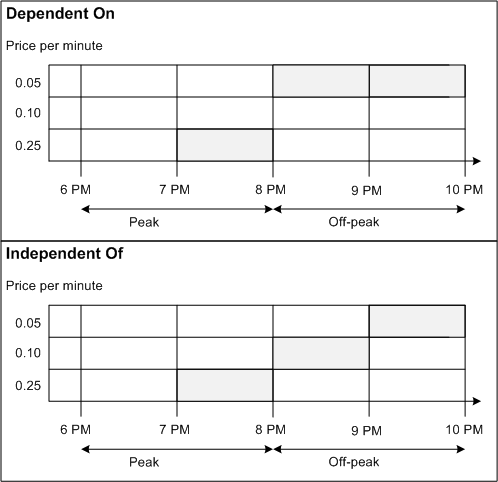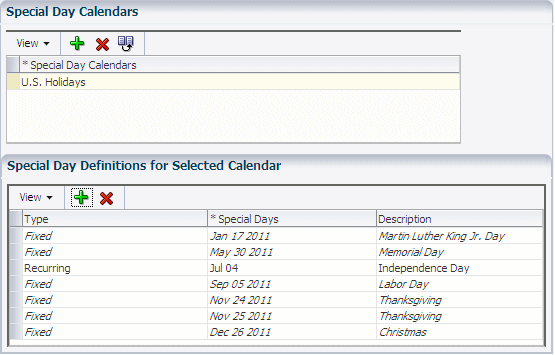17 Charging Based on Date and Time
Learn how to charge for usage events based on data and time in Oracle Communications Billing and Revenue Management (BRM).
Topics in this document:
About Charging Based on Date and Time
You can configure charge offer pricing to charge different amounts depending on the date and time. For example, you can create different pricing for peak and off-peak times. To do so, you use time models.
A time model is a set of time periods. Each time period contains one or more time segments. A time segment represents a particular time, such as a day of the week or a range of several hours.
By default, a time period is immediately and forever effective. To add effective periods to a time period, you specify only the start date of the new period. That date becomes the end date of the previous period. The end date of the final effective period is always Forever.
You can define time segments by using months, days of the month, days of the week, time of day, and a calendar of special days. For example, Figure 17-1 shows an Offpeak and a Peak time period whose time segments are defined by days of the week and time of day.
Figure 17-1 Peak and Offpeak Time Periods in a Time Model

Description of "Figure 17-1 Peak and Offpeak Time Periods in a Time Model"
About Special Day Calendars
A special day calendar is a set of dates, such as holidays, for which you want to charge special prices for your services. Each date must be one of the following types:
-
Fixed: A specific date valid only in one year, such as May 8, 2011, for Mother's Day in the U.S.
-
Recurring: A date that is valid every year, such as July 4 for Independence Day in the U.S.
Figure 17-2 shows a special day calendar that has fixed and recurring dates.
To configure pricing for special days in a charge, you associate a special day calendar with a time model. You must then configure at least one time period that applies to the special days. The time model should cover all 24 hours of the special days.
Note:
The same time period cannot apply to both regular days of the week and special days. If you configure a time period that applies to both, the time model receives a validation error.
The same calendar can be associated with multiple time models, but you can also create different calendars for different time models.
For more information, see "Creating Special Day Calendars" in PDC Online Help.
Rating Events Split across Time Periods
Events sometimes overlap time periods. For example, if off-peak rating starts at 7:30 p.m., and a call begins at 7:10 p.m. and ends at 7:35 p.m., the call overlaps the boundary between peak and off-peak rates.
When an event crosses multiple time periods, you can specify the way to charge for an event if it is priced differently by time period:
-
Start Time: Applies the charges defined in the time period in which the event begins.
-
End Time: Applies the charges defined in the time period in which the event ends.
-
Split: Applies charges according to the time period in which each portion of the event falls.
If you split charges across time periods, and you configure pricing based on quantity, you can specify the way a price step is selected when part of the event was already charged in another time period.
-
Dependent On: Dependent on the quantity already used. When selecting a price step, BRM considers the amount of the event that occurred in the previous time period.
-
Independent Of: Independent of the quantity already used. When selecting a price step, BRM does not consider the amount of the event that occurred in the previous time period.
For example, you might create pricing such as:
-
Off-peak pricing between 8 PM and 6 AM.
-
During peak time, charge 25 cents per minute.
-
During off-peak time, charge:
-
$0.10 per minute for the first hour
-
$0.05 per minute for subsequent hours
-
A phone call starts at 7 p.m. and ends at 10 p.m. This results in one hour of peak time, and two hours of off-peak time.
-
If the selection quantity is Dependent On the quantity already used, the hour charged as peak time is considered as the first hour, and the entire off-peak portion of the call is charged $0.05 per minute.
-
If the selection quantity is Independent Of the quantity already used, the hour charged as peak time is not considered as the first hour, and the off-peak portion of the call is charged $0.10 per minute for the first hour, and $0.05 for the second hour.
Figure 17-3 shows how the call is charged.
Figure 17-3 Quantity-Based Pricing Split by Time Periods

Description of "Figure 17-3 Quantity-Based Pricing Split by Time Periods"
